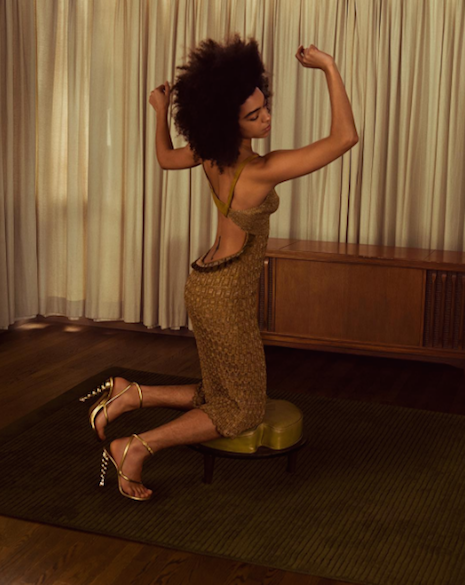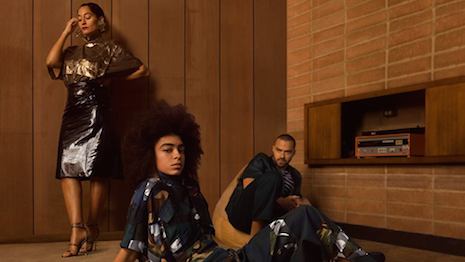French fashion label Kenzo is continuing its cinematic approach for its spring/summer 2017 campaign, which tells a musical tale.
The brand tapped Kahlil Joseph, the director behind Beyoncé’s viral visual album “Lemonade,” to create a short film. “Music is my Mistress” opts out of a narrative format, instead telling a larger story through a series of scenes.
“This short film is an extension of the collection’s spirit which is freedom of expression,” said Sebastian Jespersen, co-author of Entangled Marketing and founder/CEO of Vertic, New York. “It is a very fluid experience, where music, dialogue and ongoing dialogue are integrated in one experience.
“The brand is trying to communicate to its audience that everyone has a story to tell and musicians tell theirs through means of their craft,” he said. “In the video, music is likened to the main character of the story, making it the one thing we all pursue. By putting music on this pedestal, we as viewers see it as an endless pursuit, especially when music vanishes at the conclusion of the movie.
“In demonstrating this pursuit, Kenzo successfully entangles its customers through the means of their pursuit in music and how finding their own voice and sound can help them to tell their own stories. In brief, the underlying message behind the Kenzo brand is an empowerment to just be comfortable in your own skin.”
Mr. Jespersen is not affiliated with Kenzo, but agreed to comment as an industry expert. Kenzo was reached for comment.
Musical journey
Kenzo’s campaign stars actors Tracee Ellis Ross and Jesse Williams and musician Kelsey Lu. The print ads, shot by brothers Jalan and Jibril Durimel, capture the faces together in a slightly retro environment complete with a brick wall and wood paneling.
Music is my Mistress continues this feeling of timelessness, as the film bounces between multiple story lines.

Image from Kenzo’s spring/summer 2017 campaign
Mr. Joseph’s film opens on a preview screen, which says that it is for “appropriate audiences,” and gives the film an R rating for language and “overt blackness.”
At the opening, Ms. Lu enters a room and clicks on an amp, seemingly prepping to play her cello.
The scene abruptly changes to black and white, as a voiceover talks over footage of an operating table and Ms. Lu signing. The female narrator talks about a “musician’s musician” who was born deaf but who had sound introduced later in life as gauze is removed from an ear.
Ms. Lu is next seen driving in a car with Ish from Shabazz Palaces in the passenger seat. As they cruise, the rapper begins to lay down a verse.
When Mr. Williams’ character is introduced, he is wandering around Los Angeles looking for an address, where he is supposed to be meeting someone.
Later, Mr. Williams is seen at a house, as he complains about not being able to get hold of someone again. He says that his friend would never drive himself.
The subject of the film turns to a woman who is said to be African royalty.
Mr. Williams goes to see a princess, but finds himself stuck in the guest house waiting, as the woman he seeks will not see him until his friend arrives, too.
She waits three days, and then vanishes. The film comes full circle, ending as Ms. Lu returns to her cello and starts to perform.
Kenzo “Music is my Mistress”, a film by Kahlil Joseph
“Kahlil Joseph is a phenomenal storyteller, that is able to capture moments of visual astonishment and blissful sound,” Mr. Jespersen said. “The piece itself shows snaps of life that most of us have experienced, but never thought to put into a film of any kind. It’s these little moments that bring out the beauty in life and in all of us.
“What makes the piece even more unique is how well Joseph incorporates an almost-vaudevillian style of story,” he said. “When films were first released, they were told with music and pictures, while dialogue was left to subtitles that would appear on screen. Of course, by today’s standards, these are considered to be antiquated ways of storytelling.
“However, Joseph brings this charm back to the screen and tells a story with minimal dialogue that allows the viewers to put the pieces together. By doing this, Kenzo as a brand shows consumers what they can do to incorporate their company in the daily routine of those that relate to this type of narrative. This the brand’s attempt to be relevant to its end consumers.”
Content collaborations
Kenzo’s campaigns transcend the traditional fashion advertising format, becoming pieces of content that can stand alone.
Last season, the brand reflected on the boundaries and connections created by social media in a campaign that favored content over commerce.
The brand tapped indie filmmaker Carrie Brownstein to direct a video featuring its fall/winter 2016 collection, the result of which is a star-studded take on the relationships developed between celebrities and their fans online. With a relatable theme and an outlandish narrative, Kenzo’s social video likely found an audience outside of its own followers (see story).
Similarly, Kenzo shared homemade cake among the residents of California’s Slab City for its spring/summer 2016 collection film.
Directed by Sean Baker, “Snowbird” was filmed entirely with an iPhone and traces the journey of Theo, played by model Abbey Lee, as she traverses through the “debris-scattered [Sonoran] desert community” of Slab City, CA, known for its eccentricity and off-the-grid living. While other fashion houses are moving toward more abstract campaign films, Kenzo’s Snowbird focuses on the narrative and “eschews the glitz and glamour of fashion” (see story).
“[Kenzo’s film] will certainly be a different type of genre for those that have little experience in watching simply sights and sounds on a screen,” Mr. Jespersen said. “However, Kenzo trusts that its consumers have the ability to step out of their comfort zones and embrace something that they have never seen before.
“This short film is the brand’s affirmation that it aims to differentiate itself from the status quo, which happens to be the same kind of trait they want in their customers,” he said. “What is more important to not here, is the next step that Kenzo must take to really be able to entangle and be part of its consumers lives.”
from Apparel and accessories – Luxury Daily https://www.luxurydaily.com/kenzo-casts-music-as-central-character-in-spring-campaign-film/
via Your #1 Source to Finding Luxury & Designer Goods, Handbags & Clothes at or Below Wholesale: Click Here.

No comments:
Post a Comment